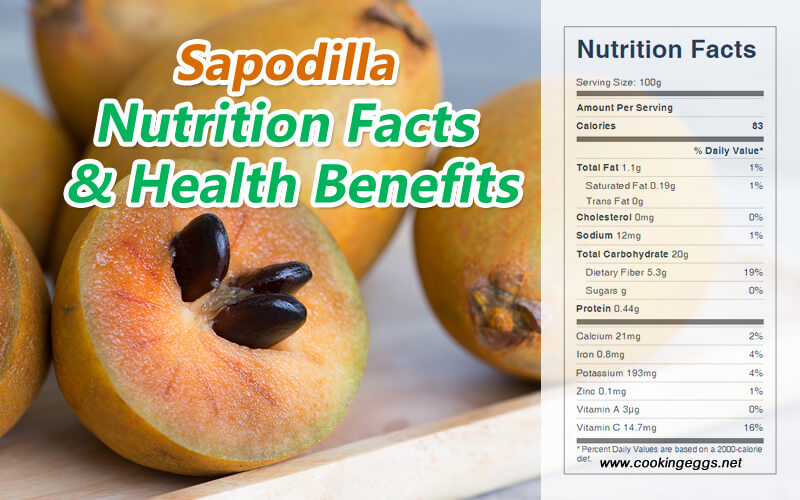Sapodilla Fruit Nutrition Facts and Health Benefits
Warning: A non-numeric value encountered in /www/wwwroot/www.cookingeggs.net/wp-content/plugins/nutrition-facts-label/nutrition-facts-label.php on line 384
The sapodilla (Manilkara zapota), also called naseberry, chiku, nispero or chicle, is native to Mexico and Central America and has been introduced to many tropical areas of the world. Cultivated in the past mostly for its latex, called chicle, to make chewing gum, the sapodilla tree is now mainly cultivated for its fruit.
Sapodilla is widely planted in South Florida, where the fruit is marketed locally and shipped to northern and eastern America. The fruit of sapodilla is small with a round to egg-shaped shape. The rough brown skin, which gives the fruit a somewhat unattractive appearance, encloses a soft, sweet, light brown to reddish-brown flesh. The flesh is often gritty, much like a pear, with a slightly fragrant and sweet flavor. However, it is not commonly seen in the United States. Sapodilla is native to southern Mexico and Central America, where it is considered to be one of the best of the tropical fruits.
Sapodilla is the source of chicle, the principal ingredient in chewing gum. The chicle is extracted from the trunk of the tree as a white latex exudate. Today, sapodilla is cultivated for its fruit in most areas. Although synthetic gums are primarily used, some countries, such as Mexico, Venezuela, and Guatemala, still grow sapodilla for chicle.

Nutritional Value of Sapodilla
The fruit of the sapodilla is high in vitamin C, fiber, iron, potassium, magnesium, sugar, and calcium. It also contains a high amount of tannin, which is an antioxidant.
Sapodilla contains 78% water, 20% carbohydrates, and a small amount of protein and fat. 100 grams of raw sapodilla provides 83 calories, 20 g carbohydrates, 5.3 g fiber, 0.44 g protein, 1.1 g fat, 3 mcg vitamin A, 14.7 mg vitamin C, 21 mg calcium, 0.8 mg iron, 12 mg magnesium, 193 mg potassium, and 0.1 mg zinc.
Raw Sapodilla Nutrition Facts Label
Health Benefits of Sapodilla
Gut Health
Sapodilla fruit is rich in dietary fiber that has multiple beneficial effects on human health. Dietary fiber is the main component in our digestive system. It helps pass the stool and bulk through the body, which forbids health conditions such as digestive disorders, colon cancer, diverticulitis, and inflammatory bowel.
Anti-diabetic Activity
Research shows that dietary fiber consumption contributes to a number of unexpected metabolic effects independent of changes in body weight, which include improvement of insulin sensitivity, modulation of the secretion of certain gut hormones, and effects on various metabolic and inflammatory markers that are associated with the metabolic syndrome. Fiber in sapodilla can regulate blood sugar, which may reduce glucose and insulin levels in diabetic patients and may lower the risk of diabetes.
Cardiovascular Health
One well-established way to reduce the risk of developing cardiovascular disease is to lower serum LDL cholesterol levels by reducing saturated fat intake. Fiber-rich foods, including sapodilla, can help lower total and LDL cholesterol, which may reduce the risk of cardiovascular disease.
Anti-inflammatory Effect
Sapodilla is rich in tannins, which is a strong anti-inflammatory agent. This anti-inflammatory agent helps to prevent inflammation and provide relief from pain. Apart from this, it also helps to prevent bowel syndrome, esophagitis, enteritis, and gastritis. As per the researchers, consuming this delicious fruit on a regular basis can reduce inflammation-related diseases in our body.
Boosts Immunity
Sapodilla is a good source of vitamin C. It is required for the functioning of several enzymes and is important for immune system function. Vitamin C distributes readily in high concentrations into immune cells, has antimicrobial and natural killer cell activities, promotes lymphocyte proliferation, and is consumed quickly during infections, effects indicating a prominent role in immune system regulation.
Use in traditional medicine
- Because of the tannin content, young fruits are boiled and the decoction taken to stop diarrhea.
- An infusion of the young fruits and flowers is drunk to relieve pulmonary complaints.
- Tea made from old leaves is drunk as a remedy for coughs, colds, and diarrhea.
- The bark can be used to make tea for treating fevers and may stop diarrhea and dysentery.
- The crushed seeds have a diuretic action and are claimed to expel bladder and kidney stones.
- A fluid extract of the crushed seeds is employed in Yucatan as a sedative and soporific.
- A combined decoction of sapodilla and chayote leaves is sweetened and taken daily to lower blood pressure.
- A paste of the seeds is applied to stings and bites from venomous animals.
- The latex is used in the tropics as a crude filling for tooth cavities.
Toxicity
The seed kernel contains 1% saponin and 0.08% of a bitter principle, sapotinin. Ingestion of more than 6 seeds causes abdominal pain and vomiting.